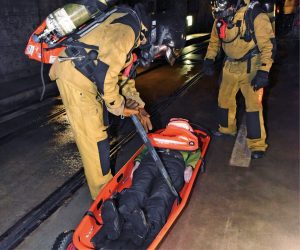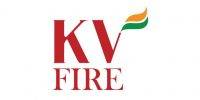
Tunnel fires are rare incidents, but they may have severe consequences: a lot of people can be affected. Seen from the fire service's point of view, the risks in tunnels mainly result from the long distance between the safe area and the area of operations. Therefore the International Fire Academy in Balsthal (Switzerland) developed special tactics and techniques to optimize firefighting in tunnels.
Extinguish fire to rescue
When rescuing people from fire hazards every second counts, as in smoke each extra breath can be fatal. Owing to the special situation prevailing in tunnels the aim is to stop smoke development as soon as possible to reduce the danger posed to tunnel users by highly toxic smoke gases and in turn, to aid self and third-party evacuation. This is why the International Fire Academy in close collaboration with many European fire services developed the principle of prioritized firefighting in tunnels (extinguishing to rescue): in the event of vehicle fires in tunnels the fire should be combated first of all to create better rescue conditions. The initial extinguishing measure – as far as possible – should always be carried out from the upstream side, in other words with the wind on account of the temperature distribution at the seat of the fire.
At the point in time when the alarm is raised it cannot be foreseen, from which side the blaze can be most quickly tackled. This leads to another tactical decision: the two-sided attack. To advance as quickly as possible to the seat of fire and to avoid traffic obstacles, a fire company is deployed from each portal of the tunnel, even if the incident may involve only a small vehicle fire or an automatic fire detection system alarm. This way, the first unit to reach the seat of fire can start the fire attack while the other can conduct search and rescue.
Avoid critical heat accumulation
Since smoke is the biggest operational hazard at tunnel incidents, firefighters entering the tunnel during a fire must have immediate access to self-contained breathing apparatus. This also applies to uninvolved tunnel tubes, if there are any; they may also quickly fill up with smoke because of the air circulation from the entrances at both ends.
 Working with breathing apparatus under the considerable weight of personal protective equipment is difficult enough. However, when this is combined with the enormous effort required to complete the necessary tasks such as carrying a victim over long distances it can lead to critical heat accumulation, resulting in a loss of performance and potentially to a serious risk to health. The length of path also exerts psychic pressure. Wearers of breathing equipment are aware that their mates are not always in a position to assist them as in the case of normal fire runs so that any mistakes they make could be fatal. This is why training experts and the International Fire Academy's tunnel firefighter procedure development team discussed the necessary tunnel operation equipment and techniques extensively.
Working with breathing apparatus under the considerable weight of personal protective equipment is difficult enough. However, when this is combined with the enormous effort required to complete the necessary tasks such as carrying a victim over long distances it can lead to critical heat accumulation, resulting in a loss of performance and potentially to a serious risk to health. The length of path also exerts psychic pressure. Wearers of breathing equipment are aware that their mates are not always in a position to assist them as in the case of normal fire runs so that any mistakes they make could be fatal. This is why training experts and the International Fire Academy's tunnel firefighter procedure development team discussed the necessary tunnel operation equipment and techniques extensively.
Aids like the search stick (on the left) and the rescue basket on rollers (on the right) facilitate searching for and rescuing tunnel users in a tunnel's large fire sections and over long distances.
Techniques and equipment
Since the firefighters would have already exerted an effort in reaching the scene from a long distance, the recommended equipment for operations was eventually limited to the essentials. Furthermore, primarily using familiar equipment would simplify the training needed and permit firefighters to perform with familiar techniques and equipment at such infrequent incidents. With less technical equipment, firefighters can concentrate more on training and exercises.
In order to restrict impacts on the firefighters when working in smoke-filled areas, the International Fire Academy has devised the following techniques:
Search sticks: Searching a large area for people by hand or with the shaft of a firefighter's axe is time-consuming and requires a lot of energy. Firefighters have to crouch or kneel and move forward in this energy-sapping stance. Therefore, the International Fire Academy recommends the use of search sticks (= optimized white canes as used by the blind). With this aid the floor can be searched quickly and thoroughly from a standing position.
The wall as safety measure: Because safety ropes presented an entanglement hazard during tunnel trials, they were considered too dangerous to use to maintain orientation, and teams using them moved much more slowly. Even in densest artificial smoke, firefighters had no trouble orienting themselves using the tunnel wall.
Thermal imaging cameras: They make operations in smoke filled tunnels much easier. They reduce the time it takes to advance in smoke and the searching of the carriageways. But: Thermal imaging cameras do not work through vehicle windows, which act like mirrors.
Marking lights: Additionally, marking lights are used to indicate the location of exits, water supplies, victim locations, and searched areas. For increased visibility LED flares are effective.
Transport aids: Because of the long distances victims must be carried. Otherwise they would sustain serious grazes if making contact with the ground. For this the use of wheeled basket stretchers is recommended. If such equipment is not available, it will take four members, instead of two, to rescue a heavy victim.
Generally speaking the emergency services are afforded acceptable conditions for combating tunnel fires from the upstream side.
Cooperate with tunnel operators
One goal of the International Fire Academy is for fire services to develop an operational plan appropriate to the tunnel in their response area. Therefore fire service's officers must know how the tunnel, especially the ventilation system, behaves in the event of fire. In this connection, the ventilation system's limits, possible breakdowns, malfunctions and operating errors must be dealt with.
The assembly space for the fire service vehicles and the possibility to establish depots for material must also be clarified. Agreement on the procedure in the event of fire and interaction during an assignment must be arrived at prior to an incident. Something that must be avoided under any circumstances is a reversal of the air (and smoke) flow without consulting the firefighters.
The operators should also be acquainted with the firefighters' procedures. As a consequence, the International Fire Academy recommends joint planning of the course of the assignment between the fire services and the operating personnel.
To ensure operational success, firefighters must know “their” tunnel(s) very well. As a result, the operators should enable the firefighters to inspect and carry out drills in the tunnel as frequently as possible.
The Gotthard road tunnel incident (2001) involving two lorries completely on fire is one of the training scenarios.
Tunnel training facilities
Not all elements of a fire in a tunnel can be trained at the station or on site. It is not possible to practice a fire attack in the actual tunnel system realistically, as this would affect the tunnel. Usually, fire services can not simulate the average traffic volume of underground transportation systems with a large variety of vehicles or railway waggons. In addition to these technical limitations empirical knowledge to design targeted training scenarios is often missing.
Since 2009 the International Fire Academy offers two well thought out tunnel training facilities, where almost all tasks of an incident operation can be simulated which may be expected in underground transport systems. Under the simulated conditions, strains on the participants are very high, without exposing them to unnecessary risks. Many participants reach their performance limits and take this as a valuable experience with them.
The tunnel pre-deployment training of the International Fire Academy provides fire services with a clear orientation for their operational tactics adapted to the tunnel in hand and supports them in their development. After the training the firefighters are familiar with the tunnel firefighting procedure. By creating an efficient and effective operation preparation specific for their tunnel they shorten operation time in the event of a fire, gain decision-making reliability, increase safety of the emergency personnel and operation success, including a reduction in consequential damages. Thus tunnel fires are dangerous, but manageable.




















































